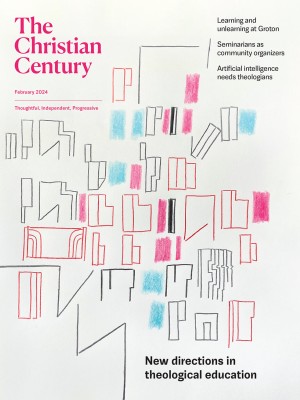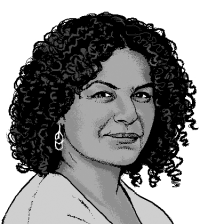Metaphors for the spiritual life
I have been an onion peeler and an excavator. I hope God will form me into a bridge.

(Image by Anton Vierietin / iStock / Getty)
When I teach writing workshops, one of the prompts I like to give my students is this: “Choose a metaphor that characterizes your spiritual life, and describe why it’s meaningful to you.” Some students head straight to the gospels. They describe wandering in the wilderness, abiding in the vine, taking up a cross, or feasting on the bread of life. Others turn to the language of the body: running a marathon, wrestling in the dark, climbing a mountain, struggling in labor. Still others draw on nature, geography, architecture, or art: “My spiritual life is a garden, a pool, a forest, a cave.” “I’m sewing a quilt, demolishing a house, restoring a painting, composing a symphony.”
I assign this prompt because the answers it yields are so rich and revealing. Within a few minutes of putting pen to paper, my students find that their spirituality is powerfully spatial, or athletic, or combative, or artistic. They discover that their God is a baker, a potter, a boxer, a field guide. Or that their approach to religious life is all about movement, or stillness, or caution, or yearning.
Read our latest issue or browse back issues.
I encourage my students to return to this exercise from time to time and redo it, because our governing metaphors don’t remain the same. They change in ways that are worth noticing.
The first time I answered the prompt myself wasn’t in a classroom; it was in spiritual direction, about 12 years ago. I was newly deconstructing, leaving the conservative evangelical faith of my childhood behind, and the language I needed was raw and visceral. “I feel like an onion,” I told my director. I was (of course) crying. “I’m an onion being peeled and peeled, and I’m afraid that when the peeling is finally over, I’ll have nothing left.”
It’s interesting to me now that my experience of the spiritual life then was purely subtractive, a wholesale falling apart. I couldn’t see that I was receiving anything. I couldn’t understand that I was participating in the peeling, or that the peeling might be for life and not death, or that the love and generosity of God were intimately involved even though the process stung. All I knew was that layer by papery layer, the spiritual life I had known and cherished for decades was coming apart. God, faith, worship, scripture, salvation—none of these was what I had thought it was. What would I be left with?
Thankfully, my fears were not realized. The peeling did go on for a long time, but it didn’t destroy me. In time, the rawness passed. The tears and the stinging passed. And the metaphor changed.
The next time I responded to the writing prompt—in a classroom this time, journaling alongside my students—I was a few years into my faith shift, and I felt stronger. Less exposed, less vulnerable, and decidedly less passive.
The image that emerged on the page was a landscape in the aftermath of an earthquake. Toppled buildings, mangled cars, vast tangles of leafy branches strewn across cracked pavement. Rubble as far as the eye could see. But also, as I looked more closely, some unlikely treasures. A perfectly preserved blown glass vase. A baby grand piano coated in white dust but intact and in tune. A multicolored quilt in a wooden trunk. A rosebush in a front yard, still blooming.
In this metaphor, I was not the thing falling apart. I was not the onion, and I was not the rubble. I was an excavator, sifting through the wreckage to find beautiful things that had survived the quake. There was scripture—not as it had been given to me in childhood, inerrant and infallible, but still precious in its astonishing complexity. There was faith—no longer a faith bound up in certainty but one that could sit with mess and mystery and find gorgeous companionship. There was God—not a God I could contain in creed and doctrine but one vast and loving enough to hold me.
Now I had work to do. Priceless gifts from my spiritual heritage to notice, honor, and extricate. Grief was still part of the work, of course; there was so much rubble, so much loss. But there were treasures, too, and I could find them. I would find them, and each one would point me toward hope and new life.
A few weeks ago, I returned to my prompt a third time. I had been asked to choose an image that represents my call to ministry. How might I visually represent my sense of vocation? What did my spiritual life literally look like? I pulled out my journal and started writing, hoping that an image would present itself.
It did. Once again, I started with a landscape. This one was not wrecked; it was healed and whole. There were trees, birds, flowers, and sunshine. There was also a deep, dark body of water with powerful currents, beautiful and formidable at the same time. And over the water, sturdy and safe, a bridge.
It took me a while to find myself in this landscape. Where was I? Amid the trees? Somewhere on the bridge? In the water?
And then I saw that the image was aspirational. I wanted to become a bridge, to help people cross over. From peeling to living, from rubble to treasure, from deconstruction to restoration. I wanted to hold out the possibility of steadiness in deep water. Ground to stand on. The hope of safe arrivals after treacherous crossings. This wasn’t something I could ever become on my own; it was what I hoped God would form within me.
My years of returning to the same writing prompt have deepened my experience of the richness of God. No image or metaphor will ever plumb the depths of what it means to be in relationship with such richness. But that doesn’t mean the language isn’t worth exploring. It only means that we’ll never exhaust the metaphors; this is a treasure that will never run out. So. What metaphor describes your spiritual life these days, and why is it meaningful to you?






